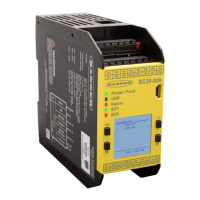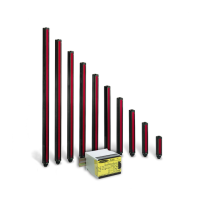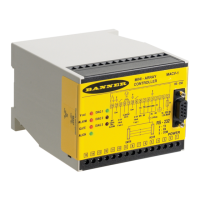4.10.2 EtherNet/IP Input Assembly Objects
Input (T->O) Assembly Objects
Instance ID Data Length (16-bit words) Description
100 (0x64) 8 Used to access the basic information about the Virtual Status Outputs
101 (0x65) 104
Used to access the advanced information (including the basic information)
about the Virtual Status Outputs
102 (0x66) 150
Used to access the fault log information and provides no Virtual Status
Output information
Output (O->T) Assembly Object
The Output Assembly Object is not implemented. However, some EtherNet/IP clients require one. If this is the
case, use Instance ID 112 (0x70) with a data length of two 16-bit words.
Configuration Assembly Object
The Configuration Assembly Object is not implemented. However, some EtherNet/IP clients require one. If this is
the case, use Instance ID 128 (0x80) with a data length of 0.
4.10.3 Industrial Ethernet - Table Row and Column Descriptions
The following are table row and column descriptions (listed in alphanumeric order) for the register maps found in
Industrial Ethernet view of the PC Interface and Fault Log Support Tables on page 48.
Table 2: Data Types
Data Type
Description
UINT Unsigned integer—16 bits
UDINT Unsigned double integer—32 bits
Word Bit string—16 bits
Dword Bit string—32 bits
String Two ASCII characters per Word (see protocol-based String information below)
Octet Reads as each byte translated to decimal separated by a dot
Hex Reads as each nibble translated to hex, paired, and then separated by a space
Fault Flag
If the particular input or output being tracked causes a lockout, a flag associated with that virtual output will be
set to 1. In Modbus/TCP, this can be read as a discrete input, input register, or holding register.
Fault Index
If the Fault Flag bit is set for a virtual output, the Fault Index will contain a number, which translates to a Fault
Code. For example, a Fault Index 41, can contain a number 201, which translates to the Fault Code 2.1; the
number 412 would translate to the Fault Code 4.12 (see Fault Code Table on page 108 for more information).
Function
The function that determines the state of that virtual output.
Operating Mode
0
Reserved
1 Reserved
2 Manual Power-up Mode ― waiting for System Reset
3 Normal Operating Mode (including I/O faults, if present)
4 Configuration Mode
5 Waiting for System Reset (exiting Configuration Mode)
6 System Lockout
Reg:Bit
Indicates the offset from 30000 or 40000 followed by the specific bit in the register.
Reserved
Registers that are reserved for internal use.
XS/SC26-2 Safety Controller
47

